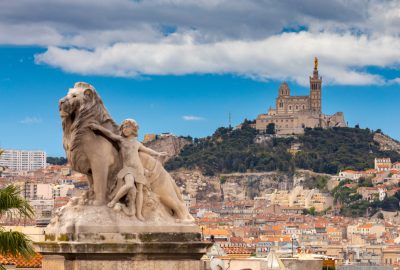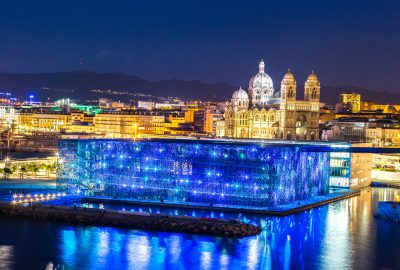I thought that the French Riviera is all about pocket little ports smelling of wine, seafood, and croissants. That’s true for most of them, apart from Marseille. Marseille is humongous. It’s the second-largest city in France as a matter of fact. I think it’s a much better destination than Paris; at least for tourism. The only thing I didn’t like about Marseille is that it was a little “unkept”. The city is like a shaggy beard. There’s ugly, bad graffiti everywhere. I mean graffiti vandalism, not a graffiti art form. Or a broken window here and there. Or the permanent renovations of certain landmarks that seem to be going nowhere. I think that people should take better care of a city of this caliber. What do I mean by caliber? You could say it is one of the oldest and most significant European cities. Marseille has been a major port during the Greek rule over the Mediterranean around 600 BC. Its location was perfect for a mish-mash of different cultures to emerge. You can see the remnants of those ancient times at Le Jardin des Vestiges. It’s a park and an archeological site with elements of millennia-old masonry.
Marseille has prospered over the ages and the Old Port (Vieux-Port de Marseille) has always been the focal point of the city. This is where the Knights Templar sailed to Jerusalem from. Église Saint-Ferréol les Augustins is where their commandery used to be. It has been rebuilt a few times over and it seems rather plain. The mysterious Abbey of St Victor is on the opposite side of the port. This one stands on top of an ancient Greek cemetery. Perhaps that’s the cause of all the misfortune that beheld this monastery of the years. A couple Viking and Saracen lootings, loss of an entire library of ancient texts; that sort of stuff. St Victor himself is supposedly buried somewhere deep below alongside artifacts from ages past. That’s the story, but what if these monks were simple graverobbers? They seemed like a naughty bunch, causing all sorts of trouble.

The Cathedral of Notre Dame de la Garde in Marseille, standing on a 149 m high limestone, can be seen from everywhere in the city; the top of the magnificent cathedral is decorated with an 11-meter statue of the Virgin Mary and Child
The Cathedral of Saint Mary Major, built in Byzantine-Roman Revival style is one of Marseille’s most eye-catching churches. But this cathedral and all other churches of Marseille pale in comparison with Notre-Dame de la Garde. It’s the symbol, the most recognizable landmark in this city. The hill it stands upon was home to a small church already in the 13th century. The basilica in its current form was built in 1864. There’s a huge golden statue of the Virgin Mary on top of the temple; it is said that it guided the sailors on their way back home. Those sailors and other believers brought a mountain of ex-votos to these walls. It’s a fancy name for an offering and the basilica is stacked with handicraft like models of ships, paintings, or just simple written letters. Many people claim they have been healed by the titular Our Lady of the Guard. Believer or not, everyone can appreciate the site and the view from up top. It can give you a perspective on exactly how many beaches there are in Marseille. You can even take a boat trip to nearby islands like Frioul or Chateau D’If. The latter one used to be a prison, but now it’s a huge Count Monte Cristo museum. There are stories about different prisoners being held here like the Man in the Iron Mask, or Marquis de Sade. It’s all fiction.

Marseille is the only city in the world with a museum dedicated to the history of the Mediterranean people and the origin of civilizations in Europe; the modern building of the museum is connected to the fortress in Marseille's Old Port
If you’re looking for that perfect sunset moment then Fort St Jean at the Old Port is the right spot. It’s one of the two imposing structures guarding the entrance to the port. Truth be told, the cannons are pointing towards the city, not towards the sea. St Jean was built to keep the unruly citizens in check, not to defend them from outside threats. There isn’t much to say about the fort itself. It gets super crowded especially around late afternoon. Trust me though, the view from the tower is worth the minor annoyances. There’s a bridge connecting it with the Museum of European and Mediterranean Civilizations. Check it out even if you’re not a fan of museums; the architecture alone is stunning. There’s also a great restaurant on the terrace. From there you can walk towards Le Panier, the Old Town of Marseille. Tiny squares and cobblestone streets; you know the drill. Great nightlife too, but the narrow alleys can get a bit dangerous after dark.




No one commented yet. Be the first.